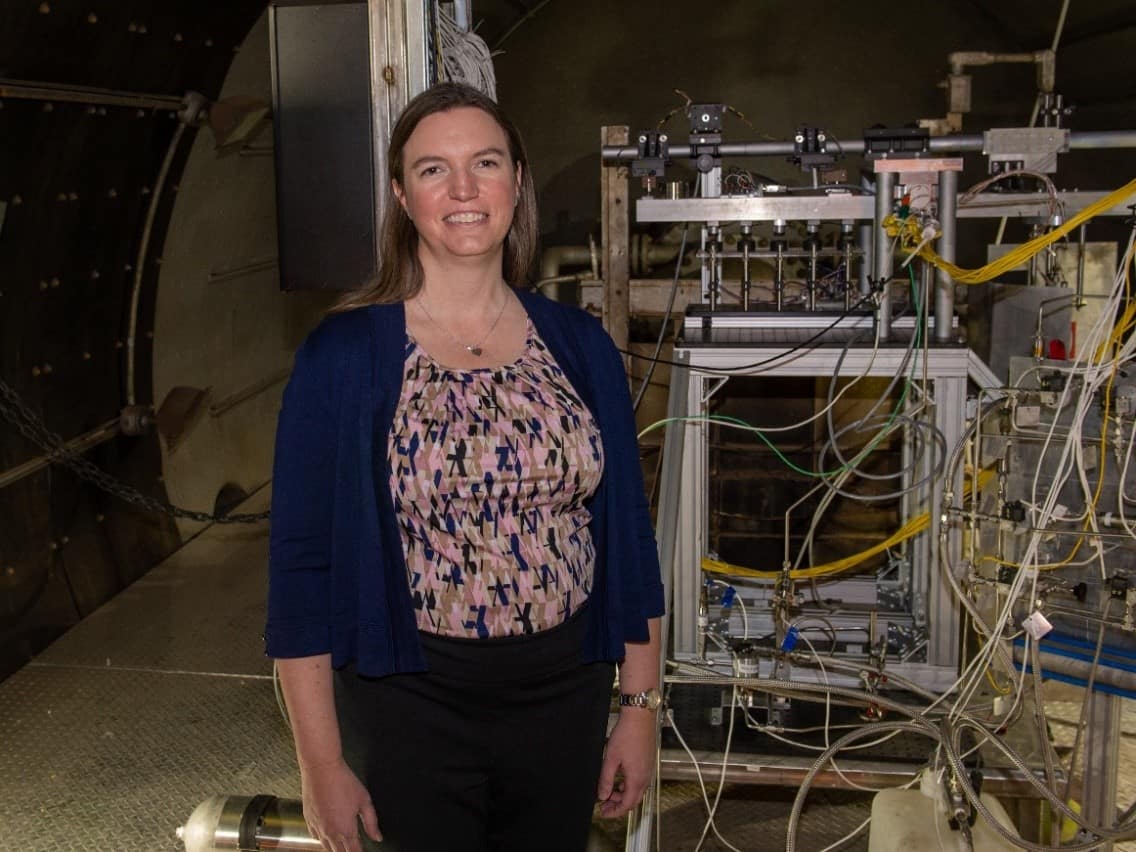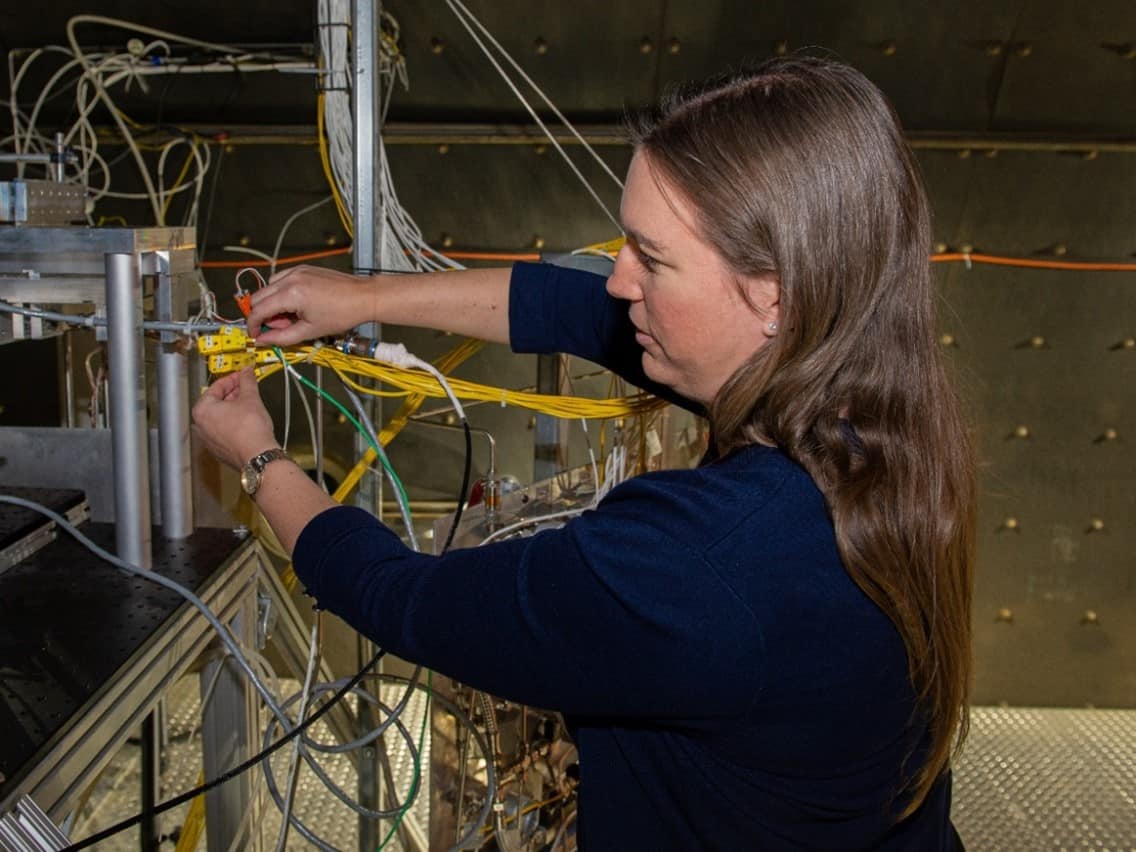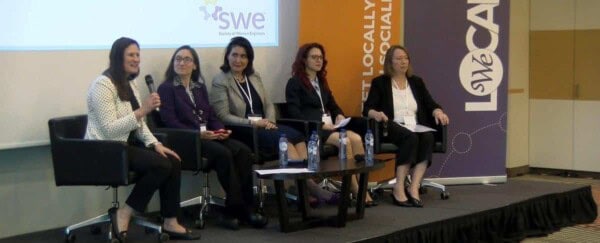Meet two amazing women from the Air Force Research Laboratory, who lead the discovery, development and delivery of warfighting technologies for the United States Air Force and Space Force. Through careers in STEM, women from across AFRL pursue a broad range of research and development efforts, work that ultimately provides Airmen and Guardians with new and innovative technologies that help keep the fight unfair.
Read their stories below and learn more about AFRL’s work with spacecraft thrusters, chemical propellants and noninvasive brain stimulation.
- Dr. Candice Hatcher-Solis, a research biological scientist
- Corinne Sedano, a senior research aerospace engineer
Dr. Candice Hatcher-Solis
Dr. Candice Hatcher-Solis is a research biological scientist in AFRL’s 711th Human Performance Wing at Wright-Patterson Air Force Base in Dayton, Ohio, and leads the neurobiology of cognitive performance team that investigates the effects of noninvasive brain stimulation. More specifically, she studies transcranial direct current stimulation, exploring how noninvasive nerve stimulation can enhance learning and memory through electrodes that target specific areas of the brain.
“The complexity of the brain makes this field [of neuroscience] exciting to me, and I’m interested in investigating a lot of the unknowns,” she said. “I feel like we are on the cusp of understanding the different effects of brain stimulation, and I’m excited to contribute findings that could advance our knowledge and provide answers.”
Through her research, Hatcher-Solis aims to learn more about human cognition, and ultimately, she strives to identify techniques that could benefit our military. However, what she enjoys most is unlocking mysteries and delivering meaningful results to the nation’s warfighters.
The “challenge and the quest for knowledge” keeps me excited, she said, noting that while “the field of neuroscience has made significant strides in understanding the many different functions of the brain, there’s still so much that’s not yet known.”

Hatcher-Solis, who grew up on military bases, said she feels a strong connection to research that benefits the nation’s Airmen and Guardians. After earning her doctorate in physiology and biophysics, she completed a yearlong fellowship with the National Institutes of Health focusing on addiction and mental health before accepting a position with AFRL.
Today, her research centers on investigating bio-molecular pathways that can enhance cognitive performance. Hatcher-Solis runs various experiments to quantify changes in the brain and she leads experimentations on how nerve stimulation can improve learning, enhance alertness, stimulate memory and counter the effects of stress, fatigue, fear and pain.
“If we understand how stimulation is affecting the brain, then we can more precisely target the regions of the brain that are mediating these effects,” she explained. Then, we can leverage that knowledge to benefit our troops with completing their missions.
Hatcher-Solis’ work in neuroscience has the potential to impact various career fields and applications within the Department of the Air Force such as intelligence gathering, surveillance and aerial reconnaissance, target identification, special operations missions and training of pilots.
“Through research, we strive to optimize cognitive performance, accelerate training and improve alertness for U.S. military forces,” she explained.
While much of her research is in the basic science stage, she collaborates with others in the lab and within her field to share knowledge and build upon current findings.
“Our ultimate goal is to develop and transition effective technologies for use in the operational environment such as wearable devices,” she said. “If we could enhance performance or output by 20 percent across a career field, that would be a game-changer,” she noted.
Hatcher-Solis finds her career with AFRL very rewarding since her work benefits a deserving group of individuals.
“I’m passionate about doing whatever I can to help our Airmen and Guardians who are defending our country,” she said.
Listen to Lab Life – Episode 42: Brain 101 and Beyond
Corinne Sedano
Corrine Sedano is senior research aerospace engineer with AFRL’s Aerospace Systems Directorate at Edwards Air Force Base, California, and currently serves as a group lead for chemical propulsion – flight programs, guiding a team of engineers and scientists in developing and testing thrusters and propellants for various spacecraft.
Her interest in space began in middle school when she completed an astronomy course and learned about the Mars Pathfinder and the Cassini mission to Saturn. Both sparked her interest in aerospace engineering and an internship during grad school working on a rocket engine led her to propulsion.
“The great thing about propulsion is that it is applicable to all [types of] spacecraft,” said Sedano. Furthermore, the test and development work involved makes for “a dynamic and exciting environment,” she said.
After earning a master’s degree, she worked as a chemical propulsion engineer at NASA’s Jet Propulsion Laboratory for more than a decade. Later, she accepted a position at AFRL to mature and develop AF-M315E, a propellant class now called Advanced Spacecraft Energetic Non-Toxic or ASCENT.
Today, this “green” propellant and the associated propulsion technology are positioned to replace hydrazine, a highly toxic substance that fueled spacecraft for the last 50 years. ASCENT boasts numerous advantages since the formula is safer for workers to handle during load operations. It also promotes improved performance in space with better fuel efficiency plus it increases satellites’ lifespans.
During a presentation at the 2021 National Space Symposium, AFRL Commander Maj. Gen. Heather Pringle asserted that “ASCENT will be key to building future U.S. Space Force architectures, all while saving money and making load operations safer for those involved.”
Sedano, who is currently working with her team to scale up ASCENT thrusters and transition the technology to industry, finds her work with AFRL to be rewarding, challenging and exciting.
“One of those really neat things about going to work every day is [when] you [realize] that you are working on hardware that is going to go into space at some point,” she said. “It’s always a surreal moment when you [help] transfer [an item] to its next stage of development.”
She is very excited about the future of ASCENT and its ability to “provide the maneuvering capabilities and support mission objectives,” noting “we are literally on the cusp of what’s possible for this propellant.”
To validate performance, her team conducts hot fire testing in vacuum chambers, examining different scenarios in relevant environments to inspect the thruster’s ability to perform during operations through a series of tests she likens to “taking a car to the test track and putting it through all the different runs.”
Sedano explained, “hot-fire testing in vacuum provides engineers with information about areas where the thruster is performing well and areas where it will need improvement.”
However, all of this work takes time, which she said requires patience, resilience and teamwork.
“Space programs take time to build, integrate, complete, launch and then still reach their destination …but at the end of the day, it all pays off when you have mission success because of the hard work you and your team put in,” she explained. Plus, “nothing can compare to the thrill of watching your propulsion system enable mission success.”
Sedano noted that teamwork and collaboration are essential to achieving goals in any area of engineering, but especially in the field of spacecraft propulsion.
“It definitely takes all different types of people and all different types of backgrounds . . . to build off of those who have gone before you and to make new work for those who come after you,” she said.
Learn more about ASCENT (Advanced Spacecraft Energetic Non-Toxic) propellant here.
Listen to Lab Life – Episode 56: Martian Milestones and Satellite Propellants here.


Author
-

SWE Blog provides up-to-date information and news about the Society and how our members are making a difference every day. You’ll find stories about SWE members, engineering, technology, and other STEM-related topics.






